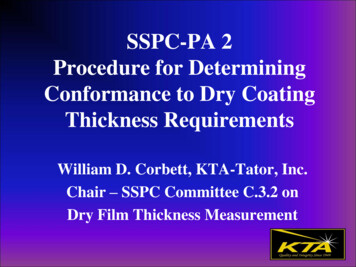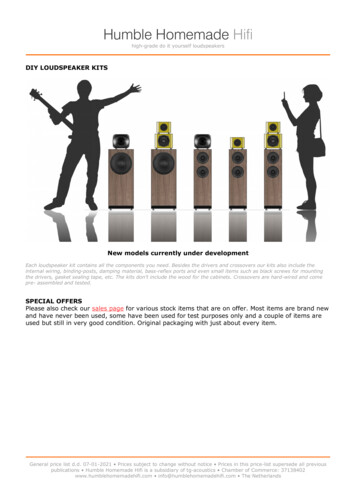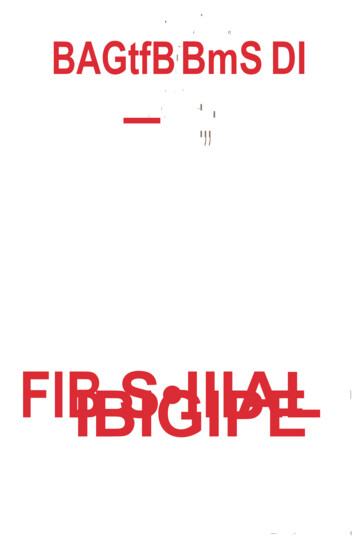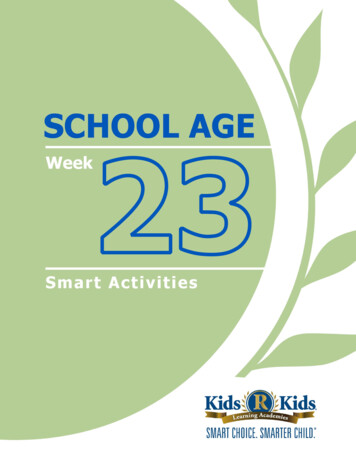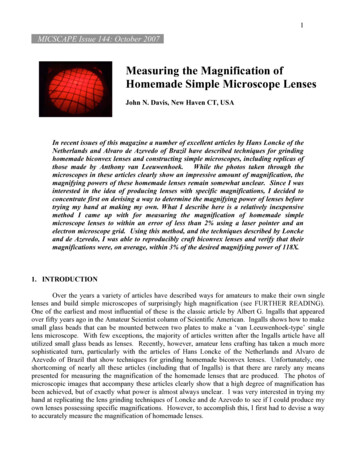
Transcription
1MICSCAPE Issue 144: October 2007 .Measuring the Magnification ofHomemade Simple Microscope LensesJohn N. Davis, New Haven CT, USAIn recent issues of this magazine a number of excellent articles by Hans Loncke of theNetherlands and Alvaro de Azevedo of Brazil have described techniques for grindinghomemade biconvex lenses and constructing simple microscopes, including replicas ofthose made by Anthony van Leeuwenhoek. While the photos taken through themicroscopes in these articles clearly show an impressive amount of magnification, themagnifying powers of these homemade lenses remain somewhat unclear. Since I wasinterested in the idea of producing lenses with specific magnifications, I decided toconcentrate first on devising a way to determine the magnifying power of lenses beforetrying my hand at making my own. What I describe here is a relatively inexpensivemethod I came up with for measuring the magnification of homemade simplemicroscope lenses to within an error of less than 2% using a laser pointer and anelectron microscope grid. Using this method, and the techniques described by Lonckeand de Azevedo, I was able to reproducibly craft biconvex lenses and verify that theirmagnifications were, on average, within 3% of the desired magnifying power of 118X.1. INTRODUCTIONOver the years a variety of articles have described ways for amateurs to make their own singlelenses and build simple microscopes of surprisingly high magnification (see FURTHER READING).One of the earliest and most influential of these is the classic article by Albert G. Ingalls that appearedover fifty years ago in the Amateur Scientist column of Scientific American. Ingalls shows how to makesmall glass beads that can be mounted between two plates to make a ‘van Leeuwenhoek-type’ singlelens microscope. With few exceptions, the majority of articles written after the Ingalls article have allutilized small glass beads as lenses. Recently, however, amateur lens crafting has taken a much moresophisticated turn, particularly with the articles of Hans Loncke of the Netherlands and Alvaro deAzevedo of Brazil that show techniques for grinding homemade biconvex lenses. Unfortunately, oneshortcoming of nearly all these articles (including that of Ingalls) is that there are rarely any meanspresented for measuring the magnification of the homemade lenses that are produced. The photos ofmicroscopic images that accompany these articles clearly show that a high degree of magnification hasbeen achieved, but of exactly what power is almost always unclear. I was very interested in trying myhand at replicating the lens grinding techniques of Loncke and de Azevedo to see if I could produce myown lenses possessing specific magnifications. However, to accomplish this, I first had to devise a wayto accurately measure the magnification of homemade lenses.
2I began by studying a very well known paper by J. van Zuylen that describes how he went aboutmeasuring the optical properties of lenses in eight of the remaining original van Leeuwenhoekmicroscopes. To measure the magnifying power of these lenses, van Zuylen built a customizedmicroscope that projected a collimated image of a test scale through a van Leeuwenhoek lens. Then,using a filar micrometer mounted below the eyepiece of the microscope, van Zuylen measured thedimensions of the magnified test scale image. Since a quick look at my Edmund Optics catalogconvinced me that building my own custom microscope of this sort was far beyond my budget, I beganconsidering less costly alternatives. It occurred to me that an inexpensive laser pointer might work as acollimated light source. Also, I remembered reading an article a number of years ago by Alan Shinn inwhich he described how to use an electron microscope specimen-mounting grid to estimate themagnification of homemade lenses. These grids are inexpensive and very precisely manufactured thinmetal screens with a distance between holes measuring in the range of microns. Thus, I suspected that Imight be able to use a simple laser pointer to cast a collimated image of an EM grid through ahomemade lens and then measure the projected image to determine the magnification of the lens. Thediagram below shows the general idea behind this strategy.2. BUILDING AN IMAGING APPARATUSInitial experiments conducted using a laser pointer, a glass bead and a pinhole punched in a pieceof aluminum foil convinced me that it was worth spending the money to purchase some EM grids andbuild an imaging apparatus to precisely measure these laser projected images. The EM grids I boughtwere Veco 75 mesh copper grids with a center reference from Ted Pella, Inc. (cat # 12555-CU) and cost 15.90 for a vial of 100. The laser pointer was a battery operated Class IIA laser with a red emissionwavelength of 630-680 nm and an output power of less than 1mW that I bought at the local pharmacyfor 3.99. I also bought some precision-made borosilicate glass balls to use as test lenses. These Iobtained from the Winsted Precision Ball Co. in three sizes: 3/32”(2.38 mm), 4/32”(3.18 mm) and5/32”(3.97 mm) in packs of 100 costing 12.53, 9.59 and 10.67 per pack, respectively. Finally, Ibought some high-quality ball lenses from Edmund Optics to use as a second set of test lenses. Theselenses are typically used in couplings for joining fiber optic cables and are made from a variety ofoptical materials. I chose the ball lenses made from sapphire (Al2O3) because they were the leastexpensive and also because they had an index of refraction of n 1.77, a value that should produceimages that are measurably different from that of the borosilicate glass balls (approximately n 1.51).Three sapphire ball lenses were ordered in the same sizes as the borosilicate glass balls at a cost of 11.00 each. Next, I needed to permanently mount an EM grid in the center of the laser beam emissionpath and then come up with a way to easily attach and remove lenses for testing. The layout I came upwith is shown in the diagram and photos on the following page.
3First, I mounted the EM grid onto a glass coverslip using tweezers to handle the grid andcellophane tape to affix it to the glass. I cut two very thin strips of tape (1-2 mm wide) with a razorblade to mount the grid by its edges to the glass, being careful not to bend or damage the grid. Using adiamond pen, I cut the glass to an approximately 1 cm square piece with the grid located at the center.Next, I superglued a magnet with a hole in its center to the head of the laser pointer. After the gluedried, I positioned the coverglass with the grid over the hole in the magnet (grid side facing the beam)and centered the grid in the beam while the laser was on. I was careful to never look directly into thebeam while doing this, but instead watched the laser dot reflected off the coverglass. I also fashioned asmall clip out of thin metal to attach to the laser pointer for hands-free operation; rotating the clipdepresses the switch button and keeps the laser on. I also made two magnetic feet to attach to the laser tomake it easy to position during imaging. The purpose of using a magnet on the laser head is to provide aconvenient means for attaching the lens holder and keeping it in place. The cardboard lens holder has athin steel strip glued to it that is attracted by the magnet on the laser head, thus making it easy to quicklymount lenses to be tested and center them in the path of the beam. The hole in the cardboard was madeusing a standard size paper hole punch and the aperture hole in the steel strip was drilled using a 2 mmdrill bit. The steel strip was also slightly indented (with the aperture hole at the center) to make a slightdepression in which the lens would sit. The front and back of two lens holders are shown in the photobelow along with the sapphire ball lenses described earlier.
4Finally, I constructed an imaging stand to hold the laser projector at a constant height so thatmeasurements could be made of the projected image. A photo of this along with a laser-projected gridimage is shown below.The imaging stand was made from a swimming pool paddling board and the handle of a lacrosse stick.An adjustable arm for holding the laser over the board was made from a sheet of brass with a steel stripadded for the magnetic feet of the laser projector to attach to. The lacrosse stick was marked off ininches to indicate the height of the arm over the board. A meter stick was used as a secondary means ofexactly measuring the height of the lens over the board after initial positioning of the arm andadjustment of the lens. As can be seen in the photo above, the laser-projected grid images that areproduced are very clear, crisp and turn out to be rather easy to measure. A quick survey using the balllenses that I had purchased indicated that the magnification was obviously increasing with decreasinglens size and was increased in the sapphire lenses relative to the borosilicate glass lenses, as expected.Below are a series of computer-generated drawings made from laser-projected grid images thatdemonstrate the effects of ball lens size and index of refraction on the projected image.The computer drawings shown to the left werecopied from drawings made by first projectingthe grid image onto a piece of paper with theroom lights dimmed, then sketching the imagewith a pencil. The height of the lens over thepaper in each drawing was 9 cm. Eachrectangle represents the size of the paper usedfor the drawing, the dimensions of which were15.2 x 23.0 cm. The clarity and reproducibilityof these images convinced me that I should beable to very accurately determine themagnification of unknown lenses.First,however, I needed to study the lens equationand calculate what the magnifications were ofthe sapphire and borosilicate glass test lensesthat I was using.
53. THE LENS EQUATIONThe general form of the lens equation is shown above. This equation relates all of the variablesinvolved in governing the optical properties of any lens. Since we are interested here in only symmetricbiconvex lenses (i.e. lenses in which the radius of curvature is equally convex for both faces) and balllenses, the general equation can be simplified to produce the two equations shown below.In these two equations: f focal length, R radius of curvature, d lens thickness, and n index ofrefraction. The radius of curvature (R) of a lens is the radius of the sphere with a surface curvaturematching that of the face of the lens. The thickness (d) of a lens is the distance between the center of thetwo faces. Note that for ball lenses the radius of curvature is equal to 1/2 the thickness or diameter of thelens. The focal length (f) is the distance between the center of the lens and the point where light passingthrough the lens converges (i.e. the focal point). Finally, the index of refraction (n) is a valuerepresenting the extent to which light is refracted (bent) by the material from which the lens is made.Different materials possess different indices of refraction. The significance of each of these variables isfurther illustrated in the series of diagrams shown below.Given the focal length (f), the magnification (M) of a lens can be derived using the formula illustratedbelow.
6The 250 mm value that appears in the magnification equation arises from the fact that the size of animage increases with increasing distance from a lens. In order to meaningfully compare the magnifyingpower among lenses, a standard distance has been agreed upon, i.e. 250 mm (approximately 10 inches),which is an estimate of the closest distance at which the eye can focus. Using the ball lens equationshown above, along with the index of refraction for borosilicate glass (n 1.51) and sapphire (n 1.77)and the diameter (thickness) of each lens (d), I was able to calculate the focal length and magnificationof each of the test ball lenses examined previously. These values are shown in the table below.Once I had calculated the magnifying power ofeach of the borosilicate glass and sapphire testlenses, I moved on to measure themagnification of these lenses based on theirlaser-projected grid images. In this way, I wasable to compare the actual or calculatedmagnifying powers shown above withmeasured values and thereby assess theaccuracy of the laser-projected grid imagemeasurement technique.4. MEASURING MAGNIFICATIONThe procedure I used to make measurements of laser-projected grid images ran as follows. Aftermounting a lens on the projector, I first positioned the arm of the imaging stand to a height ofapproximately 4 inches (10 cm) above the surface of the board. I then mounted a clean sheet of paperon the board and with the laser turned on, adjusted the lens holder so that a single grid square wasevenly centered in the field of the projected image, as shown by the starred square in the left portion ofthe diagram below.Due to the curvature of the lens, the field of view becomes increasingly distorted as one moves furtherfrom the center of the image. Thus, to obtain accurate magnification measurements, it is critical that themeasured grid square be positioned over the exact center of the field as closely as possible. Aftercentering a grid square image, the adjustable arm was repositioned to place the lens at a height ofexactly 15 inches (381 mm) over the surface of the board. This height was verified to within 1 mmusing a meter stick. The grid image produced at this second height is much larger and also fainter since
7the same quantity of light is now being cast over a larger area. Also, it is easy to lose track of whichsquare was centered after moving the adjustable arm. Therefore, I always made sure that the centeredsquare had the EM grid center reference marker in one of the corners so that I could easily return to thesame square again after moving the arm. Next, I dimmed the room lights and used a pencil to make twodots on the paper marking the location at the corners of the diagonal of the grid square image as shownin the center diagram above. Again, it is important to make these dots in the exact center of theintersection of the two grid wires or else the magnification measurement will be inaccurate. Finally, Iturned on the lights and measured the distance (x) between these two dots with a ruler to the closest 0.5mm. Six independent measurements for each lens were made in this manner.Unlike the previous calculation where the focal length (f) was utilized to arrive at a value formagnification (M), this time I needed to take a different approach since the focal length will be unknownin the homemade lenses to be tested later. When the focal length is unknown, the magnification can bederived as simply the ratio between the apparent (magnified) size of an object and its actual size. For thelaser projected grid images described here, this translates to the size of the projected image at 250 mm(D) divided by the size of the grid. To calculate the magnification from the grid images, the mean value(average) of 6 grid image distances (X) was computed and first divided by the height of the lens over theboard (381 mm) to yield the grid image size per millimeter of distance from the lens and then multipliedby the standard distance of 250 mm to yield the size of the image at the standard distance (D). Next, theimage size at the standard distance (D) was divided by the size of the original object (0.471 mm thecomparable diagonal distance on the EM grid shown in the diagram on the right above) to yield themeasured magnification value (Mm). The two formulas given below show the steps in this calculation.The table below shows the initial mean distance values (X), the calculated size of the image at thestandard distance (D), and the results of the magnification calculations for each lens. The measuredmagnification values (Mm) were compared to the actual values (M) determined earlier and the percenterror (%E) between the two is also shown.As can be seen from the table above, the percent error in the measured magnification when compared tothe actual magnification ranged between %E 0.35 - 1.52%, with an average value of 0.86%. Thus, thelaser-projected grid-imaging technique was found to be a relatively simple means for measuring themagnification of lenses to within an error of less than 2%. With this technique in hand, I next turned tothe question of crafting my own biconvex lenses using the methods described in the articles by HansLoncke and Alvaro de Azevedo.
85. CRAFTING 118X BICONVEX LENSESAs mentioned in the article by Hans Loncke, the Boerhaave Museum in the Netherlands is hometo three of the microscopes originally crafted by Anthony van Leeuwenhoek (1632 - 1723). One of theseis a small brass microscope (shown on the left below) having a magnification of 118X, as measured byJ. van Zuylen.Since the optical properties of the lens in this microscope have been thoroughly documented, I decidedto see if I could use the lens grinding techniques described by Loncke and de Azevedo to make a‘replica’ van Leeuwenhoek 118X biconvex lens.First, I carefully studied the list of optical properties reported by van Zuylen for this particularvan Leeuwenhoek lens. A scale diagram of the lens is shown above along with the list of its opticalcharacteristics. Since the borosilicate glass balls that I planned to use as lens blanks have an index ofrefraction slightly lower than that of the glass used by van Leeuwenhoek, I knew that to arrive at a 118Xlens I would have to compensate for this by slightly altering the lens thickness and radius of curvature.Thus, using the biconvex lens equation described earlier, I made a graph plotting the relationshipbetween magnification (M) and radius of curvature (R) for borosilicate glass lenses (n 1.51) with avariety of thicknesses (d 1.75 mm, d 2.00 mm and d 2.25 mm). This graph is shown below on theleft along with a scale diagram depicting the corresponding 118X lenses shown on the right.
9Inspection of the graph on the previous page suggested that a lens thickness of d 2.00 mm and a radiusof curvature of R 1.75 mm should result in a lens with a magnification very close to 118X. In thearticles by Loncke and de Azevedo, steel ball bearings were pressed into pieces of softer metal to formconcave impressions that were then used as lens grinding bits. I chose 4.0 mm diameter steel ballbearings for this purpose since the 2.0 mm radius of these ball bearings might be expected to yield aconcave grinding surface with a radius of curvature very close to 1.75 mm after the addition of grindingabrasive.Having a design for a 118X lens in hand, I next went about assembling a lens grinding lathe,similar to those used by Loncke and de Azevedo. I found that the DREMEL Single-speed Rotary PowerTool (Model # 275-02) and Router Attachment (Model # 231) are easily configured to make a veryconvenient grinding lathe. These items were purchased online from Hechinger Hardware for 36.64 and 26.09, respectively. Since the DREMEL rotary tool that I purchased was the least expensive singlespeed model (factory set speed 35,000 RPM), I needed to find a means of regulating the speed to amuch lower number of RPMs. This was accomplished by simply building an outlet box with a dimmerswitch to control the power supply to the DREMEL tool. This setup is shown in the photos below.Next, I fashioned a series of lens grinding bits by pressing 4.0 mm steel ball bearings into a 0.032” (0.81mm) thick sheet of aluminum using a bench vise. The concave impressions left by the ball bearings werethen cut from the aluminum sheet using tin snips and glued to small pieces of 4/32” (3.175 mm)diameter aluminum tubing using superglue followed by reinforcement with a hot glue gun. Theassembled lens grinding bits were then allowed to harden for 24 hrs prior to use. The 4/32” borosilicateglass balls, described earlier, were used as blanks from which the 118X biconvex lenses were ground.Superglue was used to affix the balls to the end of grinding spindles made from short lengths of 3/32”(2.38 mm) diameter aluminum tubing. These were also allowed to harden for 24 hrs prior to grinding.The grinding procedure was similar to that described by Loncke and de Azevedo and went asfollows. First, I installed a DREMEL grinding wheel on the lathe and used this to initially flatten theblanks to the appropriate height as shown in the on the following page.
10At this step, I found it important to keep the speed of the rotary tool very low or else the glass ballswould either come loose from the grinding spindle or develop chips and fractures on the ground surfaceof the glass. With the aid of a magnifying glass, I could approximate by eye how far the glass sphereneeded to be ground. After flattening the blank to the proper height, it was then ground to the desiredradius of curvature using a series of three lens grinding bits and progressively finer abrasives. In the firstbit I used a diamond paste abrasive (8 - 12 micron particle size) mixed with 80 grit abrasive that Irubbed off a piece of sandpaper. A relatively low grinding speed was used until the lens had acquired asmooth, frosted, match-head like appearance. After the lens had assumed the proper curvature, thegrinding paste was cleaned away and a second bit with diamond paste alone was employed at a slightlyhigher grinding speed. This was continued until the lens became clear and the frosted appearance fromthe previous step was gone. Again, the lens was cleaned and the last bit was employed using a very finediamond paste (1 - 2 micron particle size) until the lens became very bright and resilient. As a final step,a small piece of lens paper was placed into the bit and used to polish the lens at a very high speed. Thelens was then removed from the spindle using acetone (nail polish remover) and allowed to soakovernight before reaffixing to the spindle and grinding the other face of the lens in the same manner.The diamond paste abrasive used in this procedure was acquired from Diamond Innovations, Inc. andcost 17.73 and 7.34 for 5 grams each of the coarse and finer grained pastes, respectively.Nine lenses were crafted in this manner and the thickness of each lens was measured using amicrometer as shown in the photos below.
11Finally, the lenses were cleaned once more with lens paper and magnification measurements were madefor each lens, as described earlier. The results of these magnification measurements (Mm) along with thelens thickness measurements (dm) are highlighted in yellow in the table below.The table above shows that the thicknesses of the lenses ranged between dm 1.71 - 2.16 mm with anaverage of 1.96 mm, a value very close to the originally desired thickness of d 2.00 mm. Themagnifications ranged from Mm 115.1 - 121.0X with an average value of 117.2X, again very close tothe target magnification of M 117.9X. Using the maximum percent error found earlier (%E 1.52%)as the uncertainty in the magnification measurements (Mm 1.52%), the maximum percent differencefrom the target magnification (max %Δ) was calculated for each lens (both of these sets of values arehighlighted in blue in the table above). The max %Δ values represent the maximum amount by whichthe actual magnification can vary with respect to the target magnification given the uncertainty in themagnification measurements. As can be seen in the table, the maximum percent difference ranged frommax %Δ 1.69 - 4.15% with an average value of 2.90%. Thus, on average, the magnification of thelenses deviated from the target magnification of M 117.9X by less than 3%.6. CONCLUDING REMARKSOverall, the laser-projected grid imaging technique presented here was found to be a veryconvenient means for assessing the magnification of homemade lenses. However, there are two areaswhere the technique might be improved upon to yield even more accurate measurements ofmagnification. Error propagation analysis of the system suggests that the uncertainty in the grid imagemeasurements and those of the height of the lens over the imaging board are the primary sources of error(the variability associated with the dimensional tolerances of the ball lenses and EM grid were found tobe negligible). Since the limit to accurately reading a millimeter ruler by eye is fixed, one could improvethe accuracy of the measurements by simply increasing the size of the grid images that are projected. A1 meter square projected grid image would be expected to yield a much more accurate determination ofmagnification than the 6 - 13 cm projected images measured here. This, of course, would require a largerimaging apparatus and a more powerful laser than the battery operated laser pointer that I used forprojecting images. Another interesting prospect for future work might be to measure the degree of imagedistortion as one moves from the center of a projected grid image. This distortion appears to correlatewith the radius of curvature of the lens, thus, measurements of this distortion might provide an easymeans for determining R. Finally, it occurred to me during the preparation of this article that it might bepossible to use prepared slides, instead of an EM grid, to laser-project microscopic images of thinlysectioned specimens. In conclusion, the laser-projected grid imaging technique demonstrated here has
12proven to be a relatively inexpensive and easy means for accurately determining the magnifying powerof homemade simple microscope lenses.7. FURTHER READINGThe following is a list of links and articles on amateur lens crafting, simple microscope building and vanLeeuwenhoek microscope replica construction that I found useful in the preparation of this article. Theyare listed in chronological order of publication.Ingalls, Albert G. (1953) The Amateur Scientist: On the Fascination of Microscopy andSome Curious Amateur Observations of the moon. Scientific American, January 1953 issue:pp. 80-87.Baker, Roger C. (1991) The Homemade Microscope. Science PROBE!, April 1991 issue: pp.53-62. http://www.science-info.net/pages/Roger Baker/Shinn, Alan (1996) To Make a Leeuwenhoek Microscope Replica. Microscopy Today,volume 4 #6, January 1996 issue: pp. 14.Shinn, Alan (1996) To Make a Leeuwenhoek Microscope Replica. Web version withadditional links on estimating the magnification of a homemade lens.http://www.mindspring.com/ alshinn/Carboni, Giorgio (1996) A Glass-sphere Microscope.http://www.funsci.com/fun3 en/usph/usph.htmde Azevedo, Alvaro A. (2005) Exploring the Possibilities of Single Lens Microscopes.Micscape. September 2005 aalens.htmlde Azevedo, Alvaro A. (2006) The Challenge of Grinding Lenses for Single LensMicroscopes. Micscape, January 2006 aalens2.htmlde Azevedo, Alvaro A. (2006) The Challenge of Grinding a Miniature Biconvex Lens.The Citizen Scientist, 13 January 2006 issue.http://www.sas.org/tcs/weeklyIssues 2006/2006-01-13/project1/de Azevedo, Alvaro A. (2006) How to Prepare Abrasive Powders.The Citizen Scientist, 10 February 2006 issue.http://www.sas.org/tcs/weeklyIssues 2006/2006-02-10/project1/index.htmlde Azevedo, Alvaro A. (2006) Improving the Performance of the Single Lens Microscope.Micscape, July 2006 aa-lens3.html
13de Azevedo, Alvaro A. (2006) Building A High Power Pocket Simple Microscope.Micscape, December 2006 aa-pocket-micro.htmlde Azevedo, Alvaro A. (2007) A Novel Method for Making Miniature Lenses.Micscape, June 2007 aa-lens-new.htmlLoncke, Hans (2007) Making a van Leeuwenhoek Microscope Lens.Micscape, April 2007 hl-scope.htmlLoncke, Hans (2007) Making an Antoni van Leeuwenhoek Microscope Replica.Micscape, July 2007 hl-loncke2.htmlThe article by J. van Zuylen mentioned in the text isvan Zuylen, J. (1981) The Microscopes of Antoni van Leeuwenhoek.Journal of Microscopy, Vol. 121, Pt 3, March 1981, pp. 309-328.
for 3.99. I also bought some precision-made borosilicate glass balls to use as test lenses. These I obtained from the Winsted Precision Ball Co. in three sizes: 3/32”(2.38 mm), 4/32”(3.18





